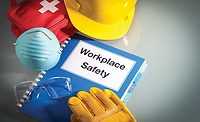Winter Roofing Safety

In most climates, roof applications below freezing are certainly not recommended. However, we all know roofers who are called upon to perform either temporary or permanent repairs as a result of ice damming or storm and tree damage during the winter months. The ensuing leaks are often difficult to locate and seemingly impossible to eliminate due to ice and snow. With daylight shortened, roof surfaces slippery, hands and feet numbed down to the cold, difficult ladder or scaffold access, and snow-buried materials, workers are often prone to taking risks not otherwise encountered on the job. The best protection for your employees under these conditions is preplanning and preparedness.
Hypothermia
Under certain environmental conditions, the body’s core temperature falls below the level required to keep the critical organs (heart, lungs and brain) functioning adequately and survival is threatened. The two causative agents promoting hypothermia are cold external temperature and moisture. As we sweat or are drenched by damp conditions, our body temperature, supplied by our metabolism and blood flow, is quickly conducted away.The technology of cold-weather clothing has recently created many new generations in protective material. Wearing a trio of layers can assist your body’s struggle against the cold and prevent the effects of hypothermia. The inner layer must be comfortable and able to “wick” the working body’s moisture away from the skin, thus creating a thermal break. Loosely woven cotton fabrics are inexpensive and available as liner products (socks and underwear). There are other materials, such as Capiline, which pull moisture away from the body.
The next layer is insulation, such as goose down, holofil or wool. Under damp conditions, however, these materials lose loft and subsequently R-value. Qualofil, polyester pile (fleece) and other manmade materials tend to keep their insulating qualities even when damp or wet. Finally, an exterior shell or a layer capable of resisting wind and moisture completes the system. While able to resist wind chill, most nylon synthetics trap body moisture, which can conduct cold. For extremely wet conditions such as freezing rain, Hypalon (synthetic rubber applied over nylon fabric) may prove your best protective shell. And as most outdoor enthusiasts agree, Gore-Tex provides the best wind resistance, rip-stop capabilities and waterproofing; and it also has the ability to “breathe” trapped moisture to the outside.
A complete change of clothes and a mylar or wool blanket should be kept on stand-by in the truck, just in case. By all means, avoid alcohol as a preventative or recovery method for hypothermia. It will only block the sensations that are indicating that hazardous exposures are occurring. Whenever hypothermia is suspected, call for emergency medical assistance immediately. Remove any wet clothing right away, place the victim in dry clothing and get them warm (in a vehicle with the heater running, and the window cracked to avoid carbon monoxide poisoning). In this way, serious health effects may be avoided.
Frostbite
This damaging condition occurs when the skin is not suitably protected from the wind and freezing temperatures. Ice particles form in the cells destroying the tissues and potentially causing gangrene. The frostbite victim first loses feeling in the affected exposed area, which is often furthest from the heart, such as the ears, nose, fingers and toes. The skin becomes cold at first and appears pale. Over time the colors change to white, yellow and blue (cyanotic) as the blood flow ceases. African-American skin color also changes slightly, becoming “waxy” and darker at the edges of exposure.
Treating frostbite requires gently bringing the affected area up to a higher temperature. Do not rub the skin since this will cause the ice particles to create further damage. Soak the area in tepid water (<105F) until the color turns pink and it remains warm to the touch. In some cases where the tissue damage is severe, blisters may develop as fluid releases under the skin. You may want to lightly cover the area with a dry, sterile dressing to prevent any secondary infection and cushion the damaged tissues until professional medical treatment is received.
Fall Protection
Even flat roofs with 24-inch parapets on four sides require fall-protection plans. Add a wet roof deck and freezing air temperatures and you’ve got a possible injury before the day is done. Temporary guardrails on a winter roof or PFAS on sloped pitches may be your best protection. Fall-in-place accidental injuries rise significantly during winter construction months, whereas fall-to-lower-level incidents remain static. Most winter fall-in-place accidents occur whenever changing direction or method of access (from ladder onto roof). Tripping over snow that has frozen solid in the afternoon is also a likely cause for falls. A snow slide could strike, taking the ladder and the worker both to the ground.When erecting a ladder-end or stairway scaffold tower, stability may be assured with proper design and erection. De-ice and clear snow with a trained, select crew before exposing the rest of the crew to work hazards. This is often a continuous process and so requires extra manpower dedicated to such tasks. If you ask the roofer repairing the roof to also maintain safe access-ways, he may choose to neglect his own safety for the completion of the repair.
No two roofs are the same and the differences are dramatically enhanced during severe winter weather. Encourage your crews to take the time to plan and prepare to avoid preventable winter roof falls. If, once on the sight, they don’t have the right equipment to protect themselves, they should be encouraged not to climb. Instruct them in competent safe work practices: Establish engineering hazard controls; obtain adequate training; and provide the necessary PPE required in your winter Job Safety Analysis.
Winter Driving
Protecting workers on the job site is obviously a concern for all employers, but how often do you take their work-related travel hazards into consideration? Five roofers in a crew-cab truck with a full ladder rack hauling rolls of 90-pound roofing, a compressor, nails, hoses, tools and a dozen pails of roof cement, can create a significant mass in motion. Air temperatures hovering around freezing, early morning unplowed roads and a frozen bridge deck could combine with that mass in motion for disastrous results.
Providing all of your roofers with a defensive driving course designed for your own particular climate could prove invaluable. It is often the case that your insurance carrier will reduce premiums when drivers of your company vehicles have an annual defensive driving course. OSHA has recently taken over work-related vehicular accidents from NHTSA as an OSHA-recordable on your 200 log. We should all be trained and practiced in winter driving techniques before we get behind the corporate wheel.
De-Icing and Snow Removal
As a contractor, I was once called upon by a customer to find and repair dozens of winter leaks on a 12,000-square-foot built-up flat roof. Our first task was to remove 24 inches of wet, heavy snow before we could inspect the roof deck. The high temperature was about 20F at noon, and fell off drastically. We had only two edges to remove the snow, so we safely barricaded the parking lot, posted a watchman below and began the task of snow blowing and shoveling. We tried several patterns of removal, but no matter how we cut it, every cubic foot of the wet snow had to be handled at least three times before it left the roof. The snow blowers were making matters worse, so we added manpower and continued shoveling.With the high dew point, every time the snow was moved, it was dampened and further compressed. As we approached the roof deck, work slowed to prevent further damage. By the end of the day, each shovel full of snow seemed close to 10 or 20 pounds. The next day we had four men out on lost-time with back injuries and another four slow-moving workers with minor injuries that were getting worse by the hour.
In the process, we removed the insulating value of the snow on top of the ice that had formed close to the warm roof deck. Daytime thaws formed roof lakes because the internal roof drain system was frozen. The -20F nighttime temperatures were increasing the ice depth several inches by the third day. We borrowed some Griffilyn® insulated tarps from a mason contractor and covered the idle square footage. We noticed that underneath a 6-ml polyethylene tarp stored behind the parapet the ice had melted wherever the sun had struck the tarp. Soon we had the roof tarped with black poly during the day while the plumbers were working on thawing the roof drains below. We were then able to remove large, wholesale slabs of ice that released from the stone ballast below from the thermal heating. Simultaneously, we used propane salamanders (with fire watches) pointed at sheets of galvanized roofing to deflect the heat and quickly dry the roof deck.
The lower back ergonomic problems caused by the snow removal actually stayed with most of the crew throughout the winter months, since we had little time off to heal. The next year we purchased ergonomically designed snow shovels with Teflon-coated blades. We also designed and fabricated an aluminum angled gang plow on skis that could be pushed by three men over a flat roof. Once a 3-foot-wide strip was shoveled next to the leading edge, this plow could peel off just enough wet or dry snow at each pass without compaction. We purchased pullover crampons for our boots (short studs) for traction. These could be used without any damage to all but membrane roofs.
That one job taught me to be better prepared with a plan before I drove off to another winter roof job. We began to profit from winter repairs once we had a crew trained for the expected, hazardous conditions and equipped with the tools that were best designed for our safety as well as the job.
Looking for a reprint of this article?
From high-res PDFs to custom plaques, order your copy today!





